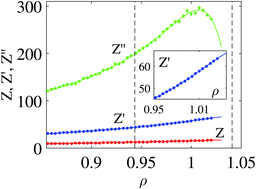Thermodynamic and dynamical properties of the hard sphere system revisited by molecular dynamics simulation
Abstract
Revised thermodynamic and dynamical properties of the hard sphere (HS) system are obtained from extensive molecular dynamics calculations carried out with large system sizes (number of particles, N) and long times. Accurate formulas for the compressibility factor of the HS solid and fluid branches are proposed, which represent the metastable region and take into account its divergence at close packing. Some basic second-order thermodynamic properties are obtained and a maximum in some of their derivatives in the metastable fluid region is found. The thermodynamic parameters associated with the melting–freezing transition have been determined to four digit accuracy, which generates accurate new values for the coexistence properties of the HS system. For the self-diffusion coefficient, D, it is shown that relatively large systems (N > 104) are required to achieve an accurate linear extrapolation of D to the infinite size limit with a D vs. N−1/3 plot. Moreover, it is found that there is a density dependence of the value of the slope in the linear regime. The density dependent correction becomes practically insignificant at higher densities and the hydrodynamic formula found in the literature is still accurate. However, with decreasing density the density dependence of the size correction cannot be neglected, which indicates that other sources of N-dependence, apart from those derived on purely hydrodynamic grounds, may also be important (and as yet unaccounted for). A detailed analytic representation of the density dependence of the HS self-diffusion coefficient and the HS viscosity, η, is given. It is shown that the HS viscosity near freezing and in the metastable region can be described well by the Krieger–Dougherty equation. Both D and η start to scale at high densities and in the metastable region in such a way that Dηp = const, where p ≃ 0.97, and D → 0 and η → ∞ at a packing fraction of 0.58, which coincides with some previous predictions of the HS glass transition density.

- This article is part of the themed collection: 2019 PCCP HOT Articles


 Please wait while we load your content...
Please wait while we load your content...